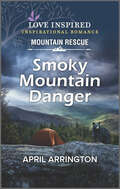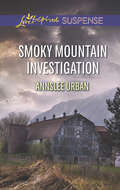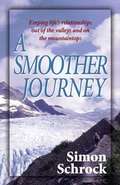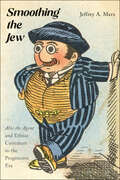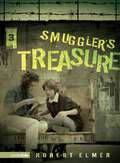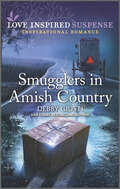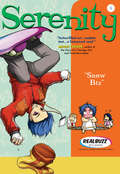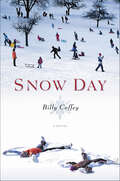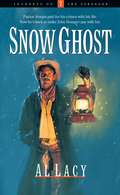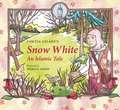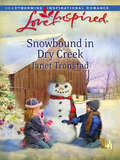- Table View
- List View
Smoky Mountain Danger (Mountain Rescue)
by April ArringtonIn the mountain wilderness…They have only one chance to make it home.Taylor Holt was sure she and her rafting group—single dad Will Morgan and his daughter—could make it down the rapids of the Great Smoky Mountains. But when disaster strikes, Will and Taylor must depend on each other to survive. With Taylor’s past still haunting her, can their tentative trust be enough to run a lethal gauntlet of dangers—and survive?
Smoky Mountain Escape
by Rhonda StarnesTwo killers on the loose and threats around every corner… Sheriff Heath Dalton accidentally stumbles upon two gunmen trying to hide a body in the Smoky Mountains and barely escapes with his life. And when traveling nurse Kayla Eldridge finds herself stranded in the stormy wilderness with Heath, she now has a target on her back. They must work together to navigate the treacherous terrain and evade the criminals who are tracking their every move. Can they outrun their merciless hunters before they both lose their lives?From Love Inspired Suspense: Courage. Danger. Faith.
Smoky Mountain Investigation: Smoky Mountain Investigation Mountain Rescue
by Annslee UrbanTo stop a killer from striking again, a journalist must reconnect with her former love in this suspenseful Southern romance.A mysterious caller taunts journalist Kylie Harper with details about a decade-old death, leading her to a new trail of murder. Who is this deranged person . . . and what does he want from her? Ex-Delta Force captain and Kylie’s former love Nick Bentley fled their Smoky Mountain hometown after the murder of their classmate. When family duty calls him back, Nick comes face-to-face with Kylie . . . and the past he’s tried to forget. Now Nick must put everything on the line to save Kylie before she becomes the next victim of a madman.
Smoother Journey, A
by Simon SchrockBiblical advice for Fulfilling Relationships Most folks going on any kind of trip plan well in advance. They do all the necessary things to make sure their travels come off without a hitch. But there is one journey so many neglect to plan for: The journey of life. The pathway to healthy friendships. Simon Schrock has accumulated a lifetime's worth of practical and profound advice grounded in God's Word, sharing this "roadmap for the trip" in A Smoother Journey. Schrock points out plain lessons for those wrestling with matters of conscience ("stop stealing!"), friends cultivating right relationships ("Johnathan and David had a beautiful relationship") and every situation in between. Schrock explains in brilliant clarity what our Heavenly Father expects from us in our daily walk. The lessons are there if the reader cares to apply them. After reading this book, you'll have no doubt as to the smoother path for life's journey.
Smoothing the Jew: "Abie the Agent" and Ethnic Caricature in the Progressive Era
by Jeffrey A. MarxThe turn of the nineteenth century in the United States saw the substantial influx of immigrants and a corresponding increase in anti-immigration and nativist tendencies among longer-settled Americans. Jewish immigrants were often the object of such animosity, being at once the object of admiration and anxiety for their perceived economic and social successes. One result was their frequent depiction in derogatory caricatures on the stage and in print. Smoothing the Jew investigates how Jewish artists of the time attempted to “smooth over” these demeaning portrayals by focusing on the first Jewish comic strip published in English, Harry Hershfield’s Abie the Agent. Jeffrey Marx demonstrates how Hershfield created a Jewish protagonist who in part reassured nativists of the Jews’ ability to assimilate into American society while also encouraging immigrants and their children that, over time, they would be able to adopt American customs without losing their distinctly Jewish identity.
Smuggler's Treasure (The Wall #3)
by Robert ElmerBerlin, spring 1989. Life is good in West Germany, and even the Cold War seems to be thawing in the warmer weather. As Liesl works on a class project about the history of the wall, she stumbles onto a startling secret no one will talk about. Will she ever learn the whole story?
Smugglers in Amish Country
by Debby GiustiA female cop teams up with her former colleague to catch smugglers in Amish country in this inspirational romantic suspense from a USA Today bestseller.When the robbery suspect she’s tracking begins attacking delivery girls in Amish country, officer Marti Sommers must go undercover as bait. With ex-cop Luke Lehman’s niece as one of the targets, this case is personal. After all, Marti’s rookie mistake ended with Luke injured and another officer dead. But can the two former colleagues stop a deadly smuggling ring . . . before Marti becomes the next victim?
Snake in the Parsonage: Award-winning Poetry
by Jean JanzenSnake in the Parsonage includes the poems for which Jean Janzen received The Creative Writing Fellowship in Poetry from the National Endowment for the Arts. Selected by a panel of major poets. Once again Jean Janzen shows us life -- colored deeply and in irrepressible light. She finds both ecstasy and incompleteness -- while waiting, at the piano and in the halls of the old people's home, lying in the field, shrieking in the cellar, standing at the blackboard.
Snare
by Katharine KerrOn the planet known as Snare, the descendants of Islamic fundamentalist emigrants have created beautiful enclaves, where they can sit on a patio enjoying green grass and "true-roses," but the nomadic tribes live in a much harsher landscape. Where the grass is purple, the trees are orange, and the huge and dangerous sentient Cha'Meech lizards roam the landscape. Idres Warkannan and his companions seek to find the only man who can redeem their Islamic civilization from its despotic ruler and restore justice to the population. Zayn Hassan, refugee from the despot's service, finds himself living among the tribes of the "comnee," where Healer and Spirit Rider Ammadin, seeing the dangers all around her, is beginning to doubt the gods who are her only protection. To save herself and her people, Ammadin journeys eastward into war, intrigue, and adventure - and finds more than she bargained for on all counts.
Sniffing Out Justice (Canine Defense #2)
by Carol J. PostA witness in peril. A K-9 protector. A fight for survival. After witnessing her best friend&’s murder, Kristina Ashbaugh-Richards and her search and rescue dog, Bella, find themselves targeted by the killer. Kris can identify the criminal—and she&’s exactly what he looks for in his victims. Her high school crush, Detective Tony Sanderson, vows to protect Kris and her son, but as they try to outwit a dangerous murderer, no place is safe to hide. With her life at stake, Kris&’s only hope of survival is to catch the serial killer before he catches her. From Love Inspired Suspense: Courage. Danger. Faith.Canine Defense Book 1: Searching for EvidenceBook 2: Sniffing Out JusticeBook 3: Uncovering the Truth
Snitch (The Occupational Hazards #2)
by Rene GutteridgeConvinced he has a greater chance to die-of boredom-at his desk job than he ever faced in narcotics, Las Vegas police sergeant Ron Yeager agrees to slip off the retirement track long enough to head up an undercover task force designed to combat the recent surge in auto thefts. Then he meets his inexperienced team of officers, most of whom seem completely incapable of infiltrating the seamy underbelly of Sin City. In particular, Mackenzie "Mack" Hazard's determination to wear her faith like a badge threatens to send Yeager's blood pressure skyrocketing. And then there's maverick Jesse Lunden, who thinks he's learned all he needs to know in his three years of undercover work. As Yeager gambles his reputation on transforming this group of egos and eccentrics into a force to be reckoned with, he stumbles onto a much bigger scheme than anyone expected. This could be the showstopper of their careers-if his back doesn't give out first. This second book in the Occupational Hazards series blends wacky characters, sincere faith, and surprising plot twists into one hilariously addictive read.From the Trade Paperback edition.
Snook Alone
by Marilyn NelsonA faithful little dog must survive on his own in the wild in this evocative tale of loss and reunion from acclaimed poet Nelson.
Snow Biz (Serenity #5)
by Realbuzz StudiosA ski trip of hot-dogging and hot-tubbing lands Serenity in hot water. Serenity's dream of the perfect ski trip is about to melt down. First she's not sure her boss will let her off work. Then she's clueless what to expect once she's actually on the slopes. One thing's certain, no one causes more friction on the slopes than Serenity.
Snow Day: A Novel
by Billy CoffeyIn this debut novel, Peter is a simple man who lives by a simple truth--a person gains strength by leaning on his constants. To him, those constants are the factory where he works, the family he loves, and the God who sustains him. But when news of job cuts comes against the backdrop of an unexpected snowstorm, his life becomes filled with far more doubts than certainties. With humor and a gift for storytelling, Billy Coffey brings you along as he spends his snow day encountering family, friends, and strangers of his small Virginia town. All have had their own battles with life's storms. Some have found redemption. Others are still seeking it. But each one offers a piece to the puzzle of why we must sometimes suffer loss, and each one will help Peter find a greater truth--our lives are made beautiful not by our big moments, but our little ones.
Snow Ghost (Journeys of the Stranger #7)
by Al LacyIn the seventh installment of the Journeys of the Stranger series, legendary hero John Stranger is called in to track the "ghost" of a murder he captured three years earlier, in Butte, Montana -- a man who had vowed to come back from the grave to kill the judge, the jury, Sheriff Johnson ... and John Stranger. Now, the jury members are turning up dead, and the people of Butte fear that Payton has come back to have his vengeance. Crow Indian legend indicates that the killer has come back as a snow ghost -- a human-shaped shadow that can be seen moving amid the falling snow. Certain that the killer is no phantom, the Stranger sets out to find the true murderer and bring him to justice in Snow Ghost.From the Trade Paperback edition.
Snow Melts in Spring (Seasons of the Tallgrass)
by Deborah VogtsShe loves the land. Mattie Evans grew up in the Flint Hills of Kansas. Although her family has lost their ranch, she still calls this land home. A skilled young veterinarian, she struggles to gain the confidence of the local ranchers. Fortunately, her best friend and staunchest supporter is John McCray, owner of the Lightning M Ranch. They both love the ranch, and can’t imagine living anywhere but in the Flint Hills. He’s haunted by it. Gil McCray, John’s estranged son, is a pro football player living in California. The ranch is where his mother died and where every aspect of the tallgrass prairie stirs unwanted memories of his older brother’s fatal accident. Gil decides leaving the ranch is the best solution for his ailing father and his own ailing heart. But he doesn’t count on falling in love. Falling in love isn’t an option. Or is it? When Mattie is called in to save a horse injured in a terrible accident, she finds herself unwillingly tossed into the middle of a family conflict. Secret pain, secret passions, and secret agendas play out against the beautiful landscapes as love leads to some unexpected conclusions about forgiveness and renewal.
Snow White: An Islamic Tale
by Fawzia Gilani Shireen AdamsInvolving the power of a djinn, poisoned dates, seven dwarf sisters-in-faith, and a mysterious old peddler woman in the woods wearing a face veil, this lyrically told story offers a unique twist on this fairy tale, whilst keeping the classic much-loved story intact, including a hateful and vain stepmother, a considerate huntsman, and a charming prince.Set in the heady snow-strewn woodlands of Anatolia by the illustrator Shireen Adams, this tale of flight, friendship, and forgiveness is richly detailed and beautifully brought to life.Snow White is the second book in the Islamic Fairy Tales series, which looks to offer meaningful and faithful variants of these popular worldwide stories.Fawzia Gilani has worked as a teacher, librarian, and school principal in the United Kingdom, United States, and Canada since 1993. She is the author of thirty children's books, mostly on the topic of Eid.
Snow on the Tulips
by Liz TolsmaA stranger&’s life hangs in the balance. But to save him is to risk everything.The war is drawing to a close, but the Nazis still occupy part of the Netherlands. After the losses she&’s endured, war widow Cornelia is only a shadow of the woman she once was. She fights now to protect her younger brother, Johan, who lives in hiding.When Johan brings Gerrit Laninga, a wounded Dutch Resistance member, to Cornelia&’s doorstep, their ives are forever altered. Although scared of the consequences of harboring a wanted man, Cornelia&’s faith won&’t let her turn him out. As she nurses Gerrit back to health, she is drawn to his fierce passion and ideals, and notices a shift within herself. Gerrit&’s intensity challenges her, making her want to live fully, despite the fear that constrains her. When the opportunity to join him in the Resistance presents itself, Cornelia must summon every ounce of courage imaginable.She is as terrified of loving Gerrit as she is of losing him. But as the winter landscape thaws, so too does her heart. Will she get a second chance at true love? She fears their story will end before it even begins.
Snowball, Dragonfly, Jew: A Novel
by Stuart RossA man reflects on family memories—that may or may not be true—in this novel of &“sharply composed vignettes with a keen sense of timing and humor&” (Publishers Weekly). Ben is an artist closing in on forty, and it&’s hard for him to be sure about the past. His parents are both dead, and his brother, who has mental issues, is a lousy source of information. So when Ben finds himself with a particularly persistent memory that keeps nagging at him, he doesn&’t know where to turn to answer the question: Did his mother really assassinate a prominent neo-Nazi? In a novel that &“shows maturity of vision without sacrificing the childish sense of play and absurdity his readers expect from him,&” Stuart Ross sends Ben ranging through childhood summers at an Ontario cottage, teenage alienation in a Toronto suburb, a disastrous college career, and the calamity that precipitates his brother&’s institutionalization—as he tries to sort through the events of his life, both real and surreal (The Globe and Mail, Toronto). &“A writer with an original sensibility.&” —The Vancouver Sun
Snowbirds
by Crissa Chappell"Snowbirds will turn your image of the Amish upside down. Lucy will grab your heart and run away with it." --Robin MacCready, winner of the Edgar award for Buried Every year, Lucy waits eagerly for the arrival of the "snowbirds," the Old Order Amish who come trundling into Florida on buses from the north, bringing Lucy's best friend Alice, with whom she's spent every winter she can remember. This winter is different. At sixteen, Alice is in the middle of "Rumspringa," a season in which Amish teens try out forbidden temptations, in order to get them out of their system. Lucy is part of a different sect, in which teens aren't allowed such bold experimentation, and she's fighting to keep up as Alice races from one wild party to the next. Then, one night after just such a party, Alice vanishes. Wracked by guilt, Lucy knows that she should have been watching out for Alice, but instead, she was kissing Faron, an Older Order boy shunned by his society. Now, Lucy plunges into a search for her best friend--while also hiding her own secret, which could put her in even more danger.
Snowbound Amish Christmas: An Uplifting Inspirational Romance (Amish of Prince Edward Island #2)
by Jo Ann BrownWill helping him at Christmas have her wishing for more? After being left at the altar, Kirsten Petersheim needs a fresh start. This means making a success of her new cleaning business and definitely not falling in love. But when her handsome client Mark Yutzy asks for her help with his troubled teenage brother, Kirsten&’s resolve is tested. As romance blossoms over the holidays, can Kirsten put her fear of heartbreak behind her and give love one more chance? AN AMISH OF PRINCE EDWARD ISLAND STORYFrom Love Inspired: Uplifting stories of faith, forgiveness and hope.Amish of Prince Edward Island Book 1: Building Her Amish DreamBook 2: Snowbound Amish Christmas
Snowbound Amish Survival
by Mary AlfordFrom USA TODAY bestselling author Mary Alford She&’s caught in a snowstorm… with a target on her back. When armed men burst into her patient&’s house looking for her, Amish midwife Hope Christner barely escapes with her pregnant friend. Now running through a snowy forest with enemies in pursuit and a blizzard raging, Hope has no choice but to turn to the closest neighbor, her ex-fiancé, Hunter Shetler. But facing the heartbreak of their past is just as frightening as the attackers on her trail…From Love Inspired Suspense: Courage. Danger. Faith.
Snowbound Escape (Pacific Northwest K-9 Unit #8)
by Dana MentinkTo rescue a witness… this K-9 team must face a killer and a storm. After months tracking a colleague falsely accused of a double homicide, officer Tanner Ford and his K-9 partner finally locate crime tech Mara Gilmore—but the real murderer is closing in. Now they must run into a frozen wilderness to survive. Evading the killer is the only way for Mara to clear her name. But will the harsh winter conditions cover their tracks…or bury them forever?From Love Inspired Suspense: Courage. Danger. Faith.Pacific Northwest K-9 Unit Book 1: Shielding the Baby by Laura Scott Book 2: Scent of Truth by Valerie Hansen Book 3: Explosive Trail by Terri Reed Book 4: Olympic Mountain Pursuit by Jodie Bailey Book 5: Threat Detection by Sharon Dunn Book 6: Cold Case Revenge by Jessica R. Patch Book 7: Undercover Operation by Maggie K. Black Book 8: Snowbound Escape by Dana Mentink
Snowbound in Dry Creek (Dry Creek Series #14)
by Janet TronstadRodeo champion Zach Lightning Lucas grumpily agrees to a Christmas Eve deal: put on a Santa suit and deliver gifts to a widowed mother. That done, he can finally leave Dry Creek, Montana, in his dust. Well, except for the small stowaway in his truck: Jenny Collins's grief-stricken little daughter. Like Zach, the girl doesn't believe in much of anything anymore. He brings her home just in time for a blizzard to strand him in lovely Jenny's barn. Where he unexpectedly helps a family--and himself-- find the meaning of Christmas.
Snowbound with the Amish Bachelor (Redemption's Amish Legacies #4)
by Patricia JohnsWill she go home when the snow stops falling? For social worker Grace Schweitzer, arriving at Ben Hochstetler&’s farm to pick up an abandoned baby feels like stepping into her past—especially after a blizzard forces her to stay. Helping on the farm reminds Grace of her Amish upbringing…and the reason she left. She&’s losing her heart to Ben and the faith she once held dear, but has she changed too much to return to this life?From Love Inspired: Uplifting stories of faith, forgiveness and hope.Redemption's Amish Legacies Book 1: The Nanny's Amish FamilyBook 2: A Precious Christmas GiftBook 3: Wife on His DoorstepBook 4: Snowbound with the Amish BachelorBook 5: Blended Amish Blessings
